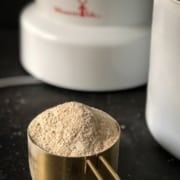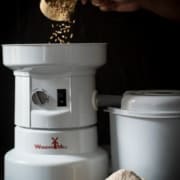Flour mill – should you buy one?
Note: This post contains affiliate links. As an Amazon Associate I earn from qualifying purchases.
If the roti you make at home tastes nothing like the ones you were accustomed to having in India, blame it on the flour (atta). Golden wheat ground to perfection is the key to a perfect roti. Find out if investing in a flour mill is worth your time and money!
Note – WonderMill sent me a grain mill to play around with, and I loved it so much that I decided to share my experience with you.
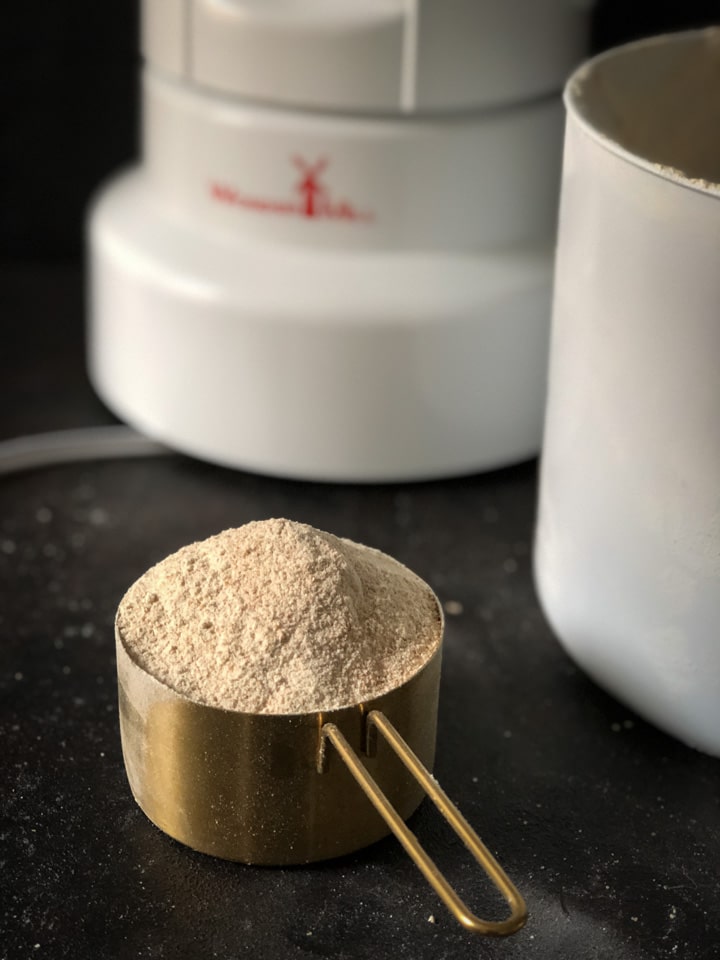
Every trip we take to India reminds us of things we don’t get here in the US – hanging out with our families, family weddings, Natural ice- cream, and freshly ground chakki ka atta (wheat flour from a flour mill) for those delicious, soft, melt-in-your-mouth rotis.
Despite knowing all the tricks and trips to make a soft and puffed-up roti, there is little one can do to improve the taste, as that factor depends on how fresh your whole wheat flour is – something we have little control over.
That’s why rotis made abroad don’t taste the same as the ones in India.
What’s the difference between store-bought flour and homemade flour?
If you are wondering, like many do, why to go through all this effort when flour can so easily be bought in a store, here are some very compelling reasons why:
- Wheat berries maintain their nutritive value until they are milled into flour. The fresher the flour, the better it is. During the conventional milling process, some of the nutritive value of the wheat berries is lost, especially if the wheat bran and germ are discarded to make the flour last longer.
- The millers often have to store the milled flour before they can package and send it to the stores. They also need to increase the shelf-life and add preservatives and chemicals to the flour.
- It is far easier to store grains than flour. The grains have a seed cover called bran that protects them from going rancid. The wheat berries can be stored at least until the next sowing season, and often longer, with proper storage.
- The flour components change during storage. The flour starts losing some of its nutritive value immediately after milling and continues to do so over the period it is stored. Millers often fortify the flour with vitamins and antioxidants, but I personally prefer my nutrition to come from natural sources.
I too like all other Indian Americans struggled to recreate the same taste and texture of roti. I tried many different brands of whole wheat flour; created my own by mixing several different kinds of whole wheat flour, but the success was limited and unsatisfactory, that is until I heard about WonderMill.
I met the folks behind WonderMill Grain Mill at a conference and I enjoyed chatting with them about India, Indians and our love for chakki ka atta. They very generously offered to send me a WonderMill (a compact grain mill) to play around with. I was ecstatic – I could grind my own grains and have freshly made flour available on demand. Yoo-hoo!
Before we talk about how the rotis turned out let me give you a quick 101 on flour mills.
What is a flour mill?
For anyone who grew up in India, a flour mill (or a chakki) is something we are very familiar with. Some of us can remember going to a neighborhood flour mill, lugging 10 pounds worth of wheat berries to get it ground.
The person doing the work would be covered from head to toe in this creamy white dust of wheat flour, would take our bag, and dump it all in this huge machine that would span his tiny shop. Depending on how busy he was at that time, you could get flour instantly, or you would have to return back at a later time.
Then came an era of home flour mills. These were smaller versions of the commercial flour mills that started getting popular in the 90s. A few families invested in their own home flour mill to grind flour as well as masalas (spices) at home.
These flour mills were pretty large, and I remember they took up a lot of space. When working, they made a deafening noise, alerting the entire neighborhood, that you were grinding flour at home. In comparison, the flour mills found in the US occupy less space and are quieter.
How is flour made?
The process to make flour at home involves investing in a grain mill, buying grains, and storing the grains/flour properly. Let’s chat through the process step by step.
Which flour mill is best for the job?
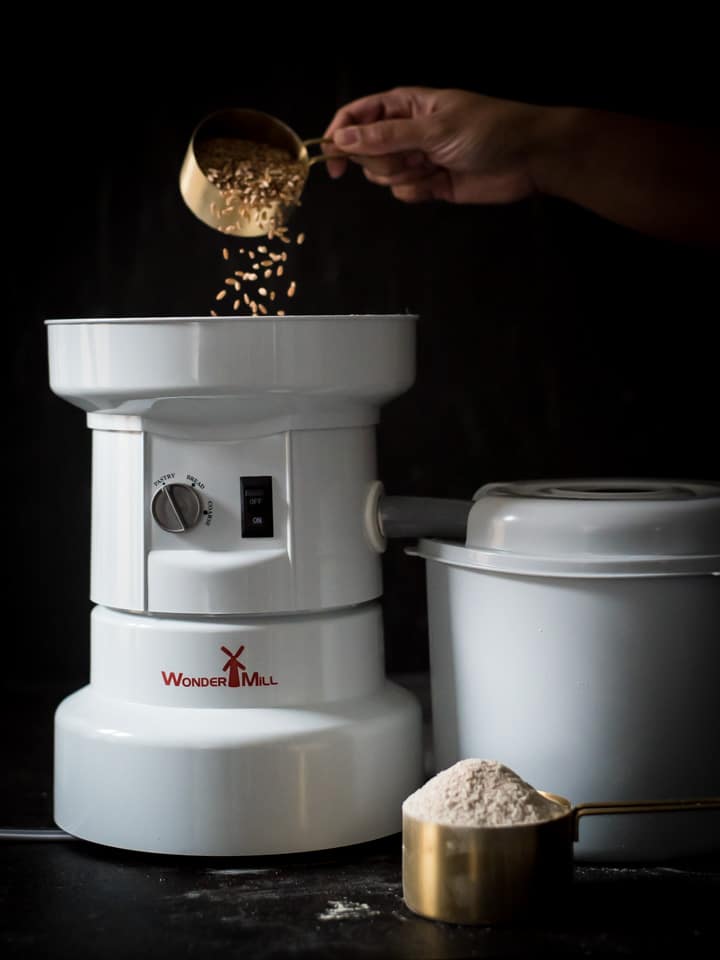
Having seen what the home mills were like in India, it was a pleasant experience to use a mill that was just as good at grinding the perfect atta for rotis, while being so much more efficient. Here is why I love WonderMill:
- Easy to set up – only five parts in total.
- Easy cleanup – It does not spew flour all over the place. No mess to clean up after you are done.
- Versatile mill – Allows personalization of flour from super fine to coarse. It is versatile and can grind a variety of grains, seeds, and legumes. Perfect for gluten-free flours.
- Preserves nutrients – Grinds at a temperature that does not destroy the nutrients of the wheat berries
- Fast and powerful – It comes with a 1250-watt heavy-duty motor designed by LG that can grind 100 pounds in an hour. You can also safely turn it off anytime during the operation.
- Low maintenance – no gaskets to be replaced, no small parts to lose
- Comes with a limited lifetime warranty.
You can not only make whole wheat flour (atta), you can also make your own rice flour, besan (chickpea flour), oats flour and many more. Check out all the grains that you can grind in a WonderMill.
Here are some helpful links for you to read up on before you decide to buy WonderMill
Where can I buy WonderMill? – Make sure you buy WonderMill from trusted retailers only. You do not receive warranty protection if you buy this grain mill from Non-Authorized sellers.
Where to buy whole grains?
I shop at the grains section at Whole foods. You can buy it online from Bob’s Red Mill or in bulk from Amazon as well. The grains last for a long time if stored in an air-tight container away from direct heat and moisture.
How to make flour at home?
This helpful video from the manufacturer’s of WonderMill will teach you how to make the most of your WonderMill in about 10 minutes.
Here’s a quick recap of the video, along with my tips
- To make whole wheat flour for rotis, the bread setting is recommended, but I prefer the pastry one for really fine flour.
- Make sure you turn the mill on, and it is running before you dump the grains in.
- You’ll need a test run and discard flour the first time you use it. So make sure you stock up on some cheap grains (not organic).
- Keep the mill running for an extra second or two after the all the grains are in. Switch it off in a few seconds when you hear a higher pitch sound. This ensures all the flour makes it to the canister.
- Unplug the power cable from the outlet and tap the canister a few times before opening up.
- Snap on the storage lid or use the flour immediately.
- Clean up the mill using a pastry brush after use.
Note – The hopper capacity is about 6 cups, and the canister can hold up to 15 cups.
How to store flour?
Make only as much flour is needed – Whole wheat flour goes rancid (smells bitter) fairly quickly as it contains the oily germ. For best results use within a week but you can store them for as long as a month. Store flour in an air-tight container in a cool, dark place.
That’s why having a grain mill like WonderMill comes in handy – since you can make flour as much as you need.
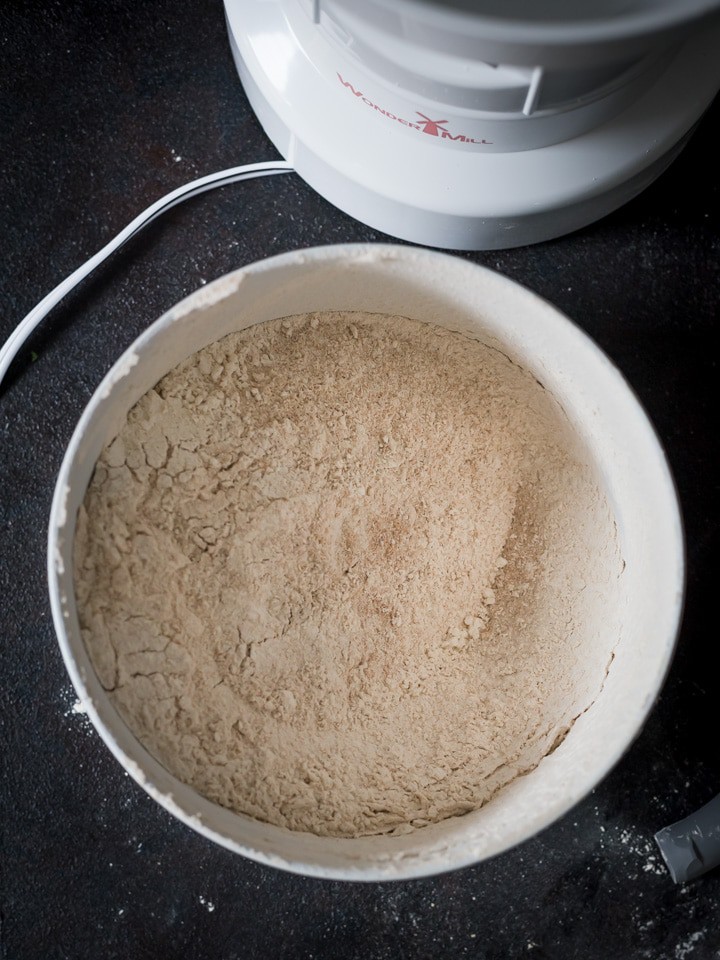
Results of using homemade wheat flour on Rotis
I know you want to know – did the roti taste great? I’ll answer that in a minute. Before that, let me quickly share my observations.
- The whole wheat flour was darker in shade compared to the store-bought one and as was the resultant dough.
- You’ll notice a difference in how the dough comes together – it is not difficult, but it doesn’t come together as easily as the store-bought ones. By that way, I use a stand-in mixer to make my chapati dough.
- Rolling process – It was easy to roll. To get tips on how to roll out perfect rotis, check out my post here.
- Taste difference – The rotis were phenomenal. Nothing like any rotis I have tasted before. Dare I say, it was even better than the ones I had in India.
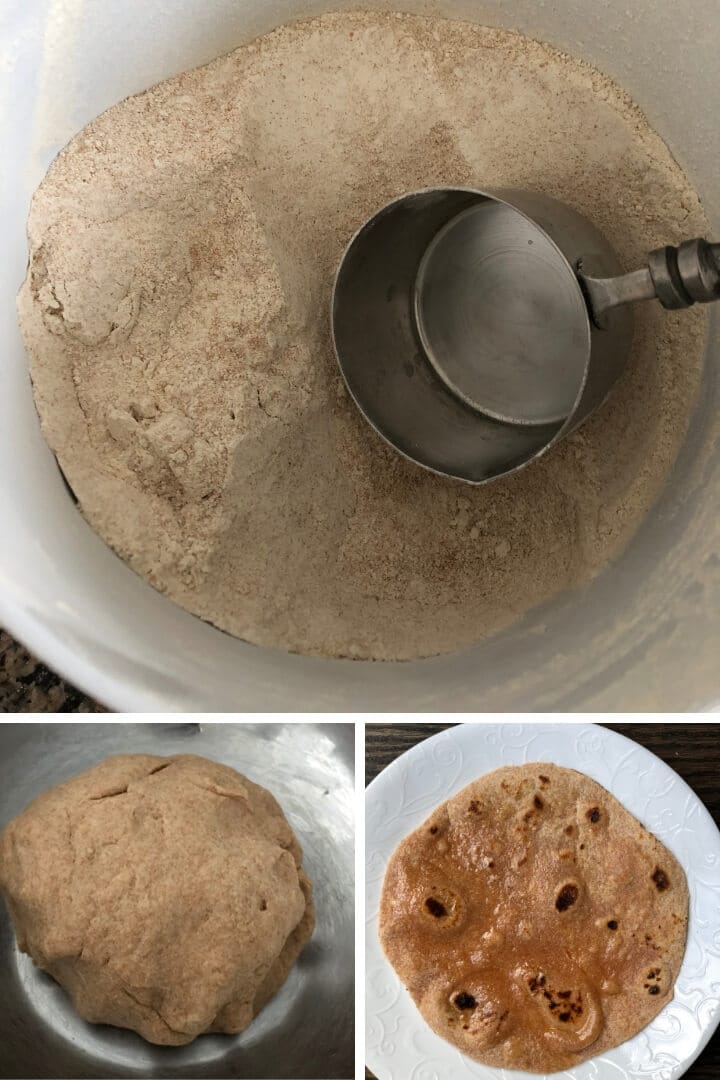
I hope this was helpful to you, and if you want to shoot me a question about WonderMill, leave a comment below.

